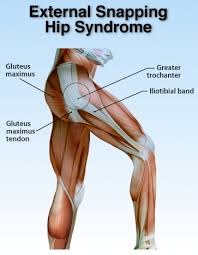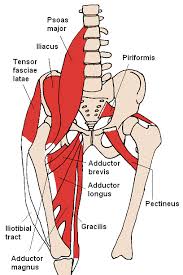
 Snapping hip syndrome, also referred to as dancer’s hip, is a medical condition characterized by a snapping sensation felt when the hip is flexed and extended.
Snapping hip syndrome, also referred to as dancer’s hip, is a medical condition characterized by a snapping sensation felt when the hip is flexed and extended.
This may be accompanied by a snapping or popping noise and pain or discomfort.
Pain often decreases with rest and diminished activity.
Snapping hip syndrome is commonly classified by the location of the snapping as either extra- articular or intra-articular.
In some cases, an audible snapping or popping noise as the tendon at the hip flexor crease moves from flexion to extension.
It can be painless.
After extended exercise, pain or discomfort may be present caused by inflammation of the iliopsoas bursae.
Pain often decreases with rest and diminished activity.
Symptoms usually last months or years without treatment and can be very painful.
The more common lateral extra-articular type of snapping hip syndrome occurs when the iliotibial band, tensor fasciae latae, or gluteus medius tendon slides back and forth across the greater trochanter.
This normal action becomes a snapping hip syndrome when one of these connective tissue bands thickens and catches with motion.
The underlying bursa may also become inflamed, causing a painful external snapping hip syndrome.
Less commonly, the iliopsoas tendon catches on the anterior inferior iliac spine, the lesser trochanter, or the iliopectineal ridge during hip extension, as the tendon moves from an anterior lateral to a posterior medial position.
With overuse, the resultant friction may eventually cause painful symptoms, resulting in muscle trauma, bursitis, or inflammation in the area.
Because the iliopsoas or hip flexor crosses directly over the anterior superior labrum of the hip, an intra-articular hip derangement of labral tears, hip impingement, loose bodies can lead to an effusion that subsequently produces internal snapping hip symptoms.
The causes of snapping hip syndrome are not fully understood.
The onset is often insidious.
Reports of a non-painful sensation or audible snapping, clicking, or popping with certain activities.
Athletes appear to have an increased risk of snapping hip syndrome due to repetitive and physically demanding movements.
Among athletes or any vigorous exerciser, repeated hip flexion can lead to injury.
In excessive weightlifting or running, the cause is usually attributed to extreme thickening of the tendons in the hip region.
Snapping hip syndrome most often occurs in people who are 15 to 40 years old.
Extra-articular snapping hip syndrome is commonly associated with leg length difference, and usually the long side is symptomatic, tightness in the iliotibial band (ITB) on the involved side, weakness in hip abductors and external rotators, poor lumbopelvic stability and abnormal foot mechanics with overpronation.
Popping during external snapping hip occurs when the thickened posterior aspect of the ITB or the anterior gluteus maximus rubs over the greater trochanter as the hip is extended.
Internal snapping hip is usually described by the patient as a snapping or locking of the hip with an audible snap and occurs when the iliopsoas tendon snaps over underlying bony prominences.
Almost half of patients with internal snapping hip also have inter-articular pathology.
The causes of intra-articular snapping hip syndrome seem to be broadly similar to those of the extra-articular type, but often include an underlying mechanical problem in the lower extremity.
The pain associated with the internal variety tends to be more intense and debilitating than with the external variety.
Intra-articular snapping hip syndrome is often indicative of injury such as a torn acetabular labrum, ligamentum teres tears, loose bodies, articular cartilage damage, or synovial chondromatosis.
Ultrasound during hip motion may visualize tendon subluxation and any accompanying bursitis when evaluating for iliopsoas involvement in medial extra-articular cases.
MRI can sometimes identify intra-articular causes of snapping hip syndrome.
This condition is usually curable.
Sometimes it heals spontaneously.
Correcting biomechanical abnormalities and stretching tightened muscles, such as the iliopsoas muscle or iliotibial band, is the goal of treatment to prevent recurrence.
Medical treatment of the condition requires determination of the underlying pathology and matching therapy to the cause.
Check muscle-tendon length and strength, perform joint mobility testing, and palpation of the affected hip over the greater trochanter for lateral symptoms during an activity such as walking.
Stretching of the tight structures- piriformis, hip abductor, and hip flexor muscle may alleviate the symptoms.
Injections are usually focused on the iliopsoas bursa.
Corticosteroid injections are common.
If medicine or physical therapy is ineffective or abnormal structures are found, surgery may be recommended.
Surgical treatment is rarely necessary unless intra-articular pathology is present.
In patients with persistently painful iliopsoas symptoms surgical release of the contracted iliopsoas tendon has been used
Iliopsoas and iliotibial band lengthening can be done arthroscopically.
Patients may require intermittent NSAID therapy or simple analgesics as they progress in activities.
If persistent pain caused by bursitis continues, a corticosteroid injection may be beneficial.
Stretching the hip into extension and limiting excessive knee flexion maximizing the stretch to the iliopsoas tendon.
Strengthening exercises for the hip flexors may also be an appropriate.
Conservative measures may resolve the problem in six to eight weeks.
Massage or self-myofascial release may be an effective intervention for external snapping hip syndromes.
Soft-tissue modalities to target the iliopsoas for medial extra-articulate snapping hip syndrome and gluteus maximus, tensor fasciae latae, and ITB complex for lateral extras-articulate snapping hip syndrome may be effective in treating symptoms of snapping hip syndrome.
